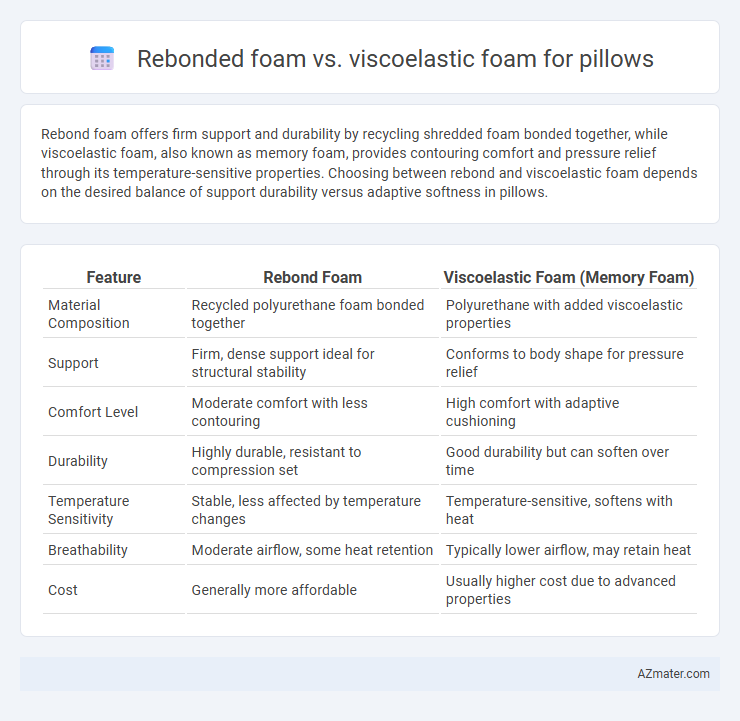Rebond foam offers firm support and durability by recycling shredded foam bonded together, while viscoelastic foam, also known as memory foam, provides contouring comfort and pressure relief through its temperature-sensitive properties. Choosing between rebond and viscoelastic foam depends on the desired balance of support durability versus adaptive softness in pillows.
Table of Comparison
| Feature | Rebond Foam | Viscoelastic Foam (Memory Foam) |
|---|---|---|
| Material Composition | Recycled polyurethane foam bonded together | Polyurethane with added viscoelastic properties |
| Support | Firm, dense support ideal for structural stability | Conforms to body shape for pressure relief |
| Comfort Level | Moderate comfort with less contouring | High comfort with adaptive cushioning |
| Durability | Highly durable, resistant to compression set | Good durability but can soften over time |
| Temperature Sensitivity | Stable, less affected by temperature changes | Temperature-sensitive, softens with heat |
| Breathability | Moderate airflow, some heat retention | Typically lower airflow, may retain heat |
| Cost | Generally more affordable | Usually higher cost due to advanced properties |
Introduction to Pillow Foam Materials
Rebond foam consists of shredded foam pieces bonded together, offering firm support and durability ideal for those requiring stable head and neck positioning. Viscoelastic foam, commonly known as memory foam, adapts to body contours by responding to heat and pressure, providing personalized comfort and pressure relief. Both materials are popular choices in pillow manufacturing, each catering to distinct sleep preferences and orthopedic needs.
What is Rebond Foam?
Rebond foam is a type of polyurethane foam made by bonding together shredded pieces of foam, resulting in a dense, durable material often used in pillows for firm support and resilience. It provides better breathability and faster response to pressure compared to viscoelastic foam, which is known for its slow contouring and heat retention. Rebond foam pillows are ideal for those seeking a supportive, bouncy feel with enhanced airflow and long-lasting structure.
What is Viscoelastic (Memory) Foam?
Viscoelastic foam, commonly known as memory foam, is a high-density polyurethane material infused with viscoelastic chemicals that enable it to slowly conform to the shape of the body, providing personalized support and pressure relief. This foam responds to heat and pressure, molding precisely to the contours of the head and neck, which enhances spinal alignment and reduces tossing and turning during sleep. Compared to rebond foam, which is made from shredded foam pieces bonded together and offers firmer, less adaptive support, viscoelastic foam excels in contouring comfort and motion isolation for pillows.
Comfort and Support Comparison
Rebond foam provides firm support and durability by compressing shredded foam pieces, making it ideal for individuals seeking consistent pressure distribution in pillows. Viscoelastic foam, commonly known as memory foam, offers superior contouring comfort by responding to body heat and weight, relieving pressure points with a softer feel. Choosing between rebond and viscoelastic foam depends on whether you prioritize resilient support or adaptive cushioning for personalized comfort.
Durability and Longevity
Rebond foam offers superior durability due to its dense structure composed of shredded foam pieces bonded together, ensuring long-lasting resilience and resistance to deformation. Viscoelastic foam, or memory foam, provides excellent contouring and pressure relief but tends to soften and degrade faster over time, especially with frequent use. For pillows prioritizing longevity and consistent support, rebond foam maintains shape and performance longer than viscoelastic alternatives.
Temperature Regulation and Breathability
Rebond foam offers moderate breathability with its open-cell structure, allowing some airflow that helps dissipate heat, making it suitable for users who prefer a cooler sleep surface. Viscoelastic foam, also known as memory foam, tends to retain heat due to its dense composition, which can trap body heat and reduce temperature regulation during sleep. Advanced viscoelastic foams incorporate gel infusions or open-cell designs to enhance breathability and improve temperature control compared to traditional memory foam variants.
Hypoallergenic and Health Factors
Rebond foam offers excellent durability and breathability, making it a hypoallergenic choice that resists dust mites and mold, thereby promoting healthier sleep environments. Viscoelastic foam, known for its contouring properties, may trap heat and moisture, potentially causing irritation for sensitive individuals despite its pressure-relief benefits. Both foams provide allergen resistance, but rebond foam's open-cell structure makes it more effective in reducing allergens and enhancing overall respiratory health during sleep.
Price and Value Differences
Rebond foam pillows generally cost less than viscoelastic (memory) foam pillows due to their simpler manufacturing process and lower material expenses. Rebond foam offers firm support and durability, making it a budget-friendly option for those prioritizing price over contouring comfort. Viscoelastic foam provides superior pressure relief and adapts to body shape but comes with a higher price tag, reflecting its enhanced value in comfort and pain reduction benefits.
Best Use Cases for Each Foam Type
Rebond foam offers firm support and durability, making it ideal for back and stomach sleepers who require consistent spinal alignment and pressure relief. Viscoelastic foam, commonly known as memory foam, contours closely to the head and neck, providing exceptional comfort and reducing pressure points, which benefits side sleepers and those with neck pain. Selecting the right foam depends on individual sleep position and comfort preferences, with rebond foam suited for firmer support and viscoelastic foam favored for contouring softness.
Which Pillow Foam is Right for You?
Rebond foam offers firm support and durability, making it ideal for those who prefer a denser pillow that maintains its shape over time, while viscoelastic foam, also known as memory foam, contours to the head and neck, providing pressure relief and personalized comfort. If you seek strong support with enhanced breathability, rebond foam suits heavier sleepers or those needing a resilient pillow. For individuals valuing softness and adaptive cushioning to reduce pain or stiffness, viscoelastic foam is the optimal choice.

Infographic: Rebond foam vs Viscoelastic foam for Pillow
 azmater.com
azmater.com